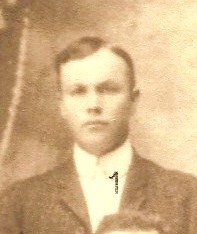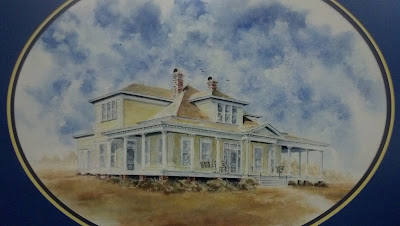
During a visit today to the General Land Office in Austin, I had the honor of holding the document pictured above in my hands, my fingers touching the same paper my Maternal (4)Great Grandfather held, and signed with his flourish of a rubric. This document signified the start of a story I am certain neither he or his wife Rachel could have imagined... This document was the formalization of a decision, without which, I could not be who I am.
LTM (Luther Thomas Martin) Plummer, came to Texas with his wife and her Family from Illinois. Rachel's Uncle, Daniel Parker, a former Illinois State Senator and predestinarian Baptist Minister, had come to Texas earlier, and had settled not far from where Rachel's Father, James, and his brother Silas chose to settle on the banks of the Navasota River, establishing Fort Parker.
This is a picture of the Limestone county land-grant map, showing LTM Plummer's land grant of one league, granted from the government of Mexico.
Fort Parker was built in the Spring of 1835, with more members of the Parker Family (Including Rachel's Grandfather John Parker and Uncle Benjamin) arriving that Fall. As an interesting aside, Rachel's Father, James Parker, attended the Consultation of Nov1835 at San Felipe de Austin, as a delegate for Viesca (Milam), where Thomas Holmes (My Grandfather on my Father's side) was a delegate for Bevil (Jasper)... amazing to imagine that they likely met, maybe even had a conversation, it would be interesting to know if Mr. Parker, being predestinarian, considered Thomas Holmes a "Bad" or Good" seed... James Parker left the meeting early due to reports of Indian troubles around Fort Parker.
LTM and Rachel continued building their lives in Texas - On the morning of 19May1836, a pregnant Rachel Parker Plummer, their two year old son James Pratt, and many other family members were left at the Fort as LTM, James Parker, and most of the men of the Fort left to work the fields that surrounded it for miles.
Later that morning a large group of Commanche appeared outside the fort. Fearing the worst, Rachel's Uncle, Benjamin Parker, decided that he would go out to meet a warrior waving a white flag to bide time for other family members to escape. Rachel stayed in the Fort, fearing she and her young son would not be able to keep up. Upon Benjamin's return to the Fort, their fears were confirmed, Benjamin warned them that they would all likely die... Rachel then wanted to flee, but was asked by her Uncle Silas to watch the front gate while he ran for his musket and powder, in Rachel's memoir she remembers her Uncle Silas saying - “They will kill Benjamin,” she reported her Uncle Silas saying, “and then me, but I will do for at least one of them, by God.” - At that moment, she heard the Indians whooping inside the Fort walls, and with her son James Pratt began to run. In her memoir she states she turned around to see her Uncle Benjamin being stabbed with Commanche spears, his act of distraction allowing many to escape, but leading to him being the first of the casualties in the Fort Parker Massacre.

Below are pictures of Benjamin Parker's Bible, taken from Fort Parker by the Indians, and later recovered, now housed at the Brisco Center for American History at UT Austin... today as I visited the special collections, and they delivered the plain brown envelope to me, I felt privileged to be able to hold a Bible that bore witness to events that seem almost unbelievable today...
My Great Uncle, Jim Plummer, wrote of his visit with the Bible, saying "I held that Bible in my hands while at the same time closing my eyes wondering if Benjamin Parker had been able to read even a few scriptures from it on the morning of May 19, 1836, before some 500 Indians would ride their horses slowly out of the woods to the clearing not far from Fort Parker's main gate." It is hard to describe the feelings that emerge while holding that Bible...
During the raid of Fort Parker, it is remarkable that only five settlers were killed, and five settlers captured, with the remainder escaping thanks to Benjamin Parker.
Included among those captured were Rachel Plummer and her young son James Pratt Plummer, as well as Rachel's cousin, Cynthia Ann Parker, who would go on to marry a Commanche Chief, and become the mother of Quanah Parker, last chief of the free Commanche, and contemporary of president Theodor Roosevelt.
LTM returned from the fields to find the bodies of his Rachel's Uncle and Grandfather among the dead scattered in the ashes of Fort Parker, and his Wife and Son taken. He immediately began searching for Rachel and his son, as did Rachel's father James Parker.
 Rachel was seperated from her son James Pratt shortly after the raid, when the Commanche learned he was weaned. She never saw her son James Pratt again... Rachel, who was pregnant at the time of her adbuction, bore her second son around October of 1836, and named him Luther... her Commanche captives felt the child was interfering with her work as a slave, so they dragged the child to death, returning the dead baby to her as illustrated by O. Henry in the book "Indian Depredations in Texas, by JW Wilbarger.
Rachel was seperated from her son James Pratt shortly after the raid, when the Commanche learned he was weaned. She never saw her son James Pratt again... Rachel, who was pregnant at the time of her adbuction, bore her second son around October of 1836, and named him Luther... her Commanche captives felt the child was interfering with her work as a slave, so they dragged the child to death, returning the dead baby to her as illustrated by O. Henry in the book "Indian Depredations in Texas, by JW Wilbarger.
Rachel was ransomed from the Commanche on 19Jun1837 north of Santa Fe, and returned to her husband in Texas on 19Feb1838, emaciated and covered in scars. She wrote a narrative of her ordeal, titled "Rachel Plummer's Narrative of 21 Months Servitute as a Prisoner Among the Commanchee Indians" which was published in Houston in 1838, becoming the first published account of Indian abduction in Texas, and was a sensation not only in the Republic, but also in the United States and even Abroad. Rachel bore a third child in Jan 1839, and died shortly thereafter.
 As another aside, Rachel's Cousin, the famous Cynthia Ann Parker, mother of Quanah Parker, was not returned to her European American Family until 1860, and after so many years with the Commanche, had forgotten most of her former life. Her son, Quanah Parker, became a leader among the Commanche, and is known as the last free chief of the plains Commanche. Before leading his band to Fort Sill, he was wanted by the US Army for raids on Anglo settlements. Pictured is the original press used to print the Quanah Parker "Reward" posters, in the early days of Fort Sill. This artifact resides in the collection of 717North.
As another aside, Rachel's Cousin, the famous Cynthia Ann Parker, mother of Quanah Parker, was not returned to her European American Family until 1860, and after so many years with the Commanche, had forgotten most of her former life. Her son, Quanah Parker, became a leader among the Commanche, and is known as the last free chief of the plains Commanche. Before leading his band to Fort Sill, he was wanted by the US Army for raids on Anglo settlements. Pictured is the original press used to print the Quanah Parker "Reward" posters, in the early days of Fort Sill. This artifact resides in the collection of 717North.
At some point there appears to have been a falling out between LTM Plummer and Rachel's Father, some believe because James Parker felt that LTM had not done enough to aid in the rescue of Rachel and James Pratt... When James Pratt was finally ransomed in 1842, by $500 paid by the Republic of Texas, James Parker refused to return James Pratt Plummer to his Father, LTM Plummer, unless LTM paid James Parker $500. LTM Plummer wrote to President Sam Houston regarding the matter, and Sam Houston sided with LTM, stating that as the Republic of Texas had paid the ransom, no moneys were due to James Parker, and ordered LTM and his son be reunited.
 There are many intricacies of this story, and entire chapters of books dedicated to its explanation, with James Parker going on to revise Rachel Plummer's story and publish it again with a book of his own, and over time the reputation of LTM Plummer was tarnished by the words of his former Father-in-law,
There are many intricacies of this story, and entire chapters of books dedicated to its explanation, with James Parker going on to revise Rachel Plummer's story and publish it again with a book of his own, and over time the reputation of LTM Plummer was tarnished by the words of his former Father-in-law,The picture to the right is LTM Plummer, thought to have been taken in the 1880s.
LTM later married Angeline Glenn, and their son Hinton Plummer married Ada Vera Hines, their son James Luther Plummer married Maude Terry, both pictured below:
James Luther and Maude Terry's son, James Garland Plummer was born in Groesbeck TX, just a few miles away from Fort Parker, he was my Great-Grandfather, and was eight when his parents died one day apart in October 1918, during the 1918 Flu Pandemic. He grew up in crazy times, and once told me a story of one of his childhood friends who was black, whose father was lynched... he told me he remembered his friends father hanging from a tree, and how profoundly that affected him, and taught him that hate was never an option.
James Garland went on to marry Ozella Evelyn Parsons, pictured below with their eldest daughter, my Grandmother, Juanita Sue (Nina) Plummer. Juanita had a twin who died as an infant of meningitis, and two younger siblings, Rita Faye and James Garland Jr. (Jim)
I was lucky enough to spend alot of time with my Great-Grandparents, and I attribute my love of plants to James Garland, who seemed to be able to grow literally anything, and my love of history to Ozella, who literally wrote a novel on the back of every picture she ever took and had a bookcase filled with everything from "Rachel Plummers Narrative" to "Archaeological Digest". I can remember them taking me to the Jim Hogg Plantation, or to reunions at the Plummer Cemetery in Limestone County (I remember one of those reunions being the first time I heard a peacock call, which as a kid can be pretty scary) or to the Antique Rose Emporium in Independence. I remember, at maybe 6 or 7 years old, my Granny-Plummer teaching me the meaning of the words "translucent" versus "transparent" using a container of rocks that she kept just inside the back door... it seems that almost every encounter was used to instill some sort of knowledge, or even better, a curiosity for the world around us. All of this because LTM Plummer fell in love with a Parker, and decided on a crazy adventure in the Mexican Province of Texas y Coahuila.
The popup valentine given in 1933 to Ozella Parsons, from James Garland Plummer.





























